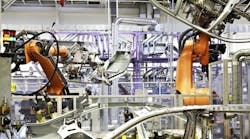Nothing good tends to come from something that is broken. It’s bad enough to have to deal with problems in the factory: The average manufacturer deals with around 800 hours of downtime annually, which translates to almost $1 million in lost revenue.
What’s even more costly is when automotive makers have to deal with problems on the road. Back in 2014, more than 64 million vehicles were taken off the market due to defects. Since the start of 2018 we have seen Tesla recall 123,000 Model S cars; Ford recall nearly 350,000 F-series pickup trucks and expeditions; and Toyota recall 21,000 Toyota and Lexus cars.
Recalls are expensive. Connected technology and simulation can not only mimic real life, but also offer a confidence rating. For example, there might be a confidence level of 10% that a belt needs to be replaced in the next five days. This maintenance doesn’t sound too worrisome, so it’s skipped. Three days later software might show that the confidence level has increase to 95% that the machine needs a new belt. This not only prevents downtime from machines breaking, but alerts technicians before a machine might start producing parts that are out of tolerance and would need to be scrapped.
After the Tesla announcement alone, shares fell 4%—a decline made all the more pertinent in June when almost 10% of the company’s global workforce was made redundant, as it looks to steady the ship and win back investor confidence in its business model. Ultimately, recalls, mistakes, and broken parts make headlines around the world, costing brands millions in repairs and untold reputational damage.
For years, the conventional approach was to fix what was broken. Then more manufacturers began to take a preventative approach that used a combination of physics-based models of the machines and knowledge of past failures to determine at what interval a particular type of machine is likely to need repairing in order to catch known problems in time. This approach was effective for handling known problems, but couldn’t detect the unknown problems which happen much more often in the field.
Now, with the advancements in cognitive learning and the proliferation of IoT sensors across production lines, we are entering a new stage of predictive maintenance. This is where AI, machine learning, and predictive analytics can enable manufacturers to gain full visibility and control of manufacturing processes—not only to prepare for the known issues, but also to effectively predict and prevent the unknown.
Not only can simulation software help prevent recalls, but collecting data on cars in the field can tell users when maintenance is needed before they become stranded. (Pictured: 2018 Dodge Challenger SRT Demon)
Predicting from the factory to the road. We can’t turn back time yet, despite all of the advancements made in technology. However, what we can do is almost as impressive. New cognitive technologies can analyze data in ways that were never thought possible. Previous manual data modelling allowed for manufacturers to use past failures to predict future ones. AI-powered platforms use cognitive learning which not only uses past failures to teach themselves, but can learn to anticipate ones that have never happened before. The importance of this cannot be understated, as many of the issues that cause recalls tend to be new ones.
Through teaching themselves with data from sensors, cognitive applications are able to learn the conventional operating conditions and environmental influences on machines at a micro level, going beyond the macro-patterns that human brain tends to spot. This means that micro-anomalies and small changes that can go undetected in the quality check process can now be identified automatically as they occur. In this way, breakdowns or faults can be predicted ahead of time, before they spark recalls or cause downtime.
In order to make sure the technology is being used most effectively, manufacturers should look to deploy it across a number of touchpoints in the production process. During the initial manufacturing process, cognitive predictive maintenance can identify and share alerts on in-line defects. This allows for problems to be addressed long before the product goes to market.
Looking after the backstage actors, as well. It’s not just the consumer-facing vehicles that can be monitored. Cognitive predictive maintenance also allows for the production line machinery being used to build the parts to be kept running smoothly, as well. Using industrial IoT and sensors found throughout manufacturing plants these days, we can now understand the health of a machine in minute detail. This is achieved through the creation of “digital twins,” which are granular digital copies of physical machines.
What this means is that you can have an exact digital simulation of all your physical machines running in conjunction at all times, giving your machine the tools to see their own future from a maintenance perspective. The introduction of cognitive learning into this process means that the digital twin is capable of analyzing and reporting back on its own health, helping fix issues well in advance of them happening.
But what about when the product goes to market? The role of predictive maintenance doesn’t stop once the vehicle is out of the factory. In the field, the cognitive predictive maintenance model can be derived from multiple data sources, like data collected from connected vehicles and service records; test data on parts that have been replaced; and even external factors like weather conditions, road conditions, attention and biometric sensors for drivers, and social media. This data can be used to identify and solve problems faster, either to avoid a breakdown altogether, or to initiate the maintenance procedure sooner and plan parts inventory and field personnel availability better.
Looking ahead. The use of cognitive predictive maintenance is not a luxury or a toy reserved for the biggest manufacturers. This technology is becoming essential in an industry where the smallest advantage can mean millions of dollars. The most exciting part is that this is just the start in terms of where cognitive technology will take the automotive industry.
Ruban Phukan is VP Product, Cognitive-First at Progress.



